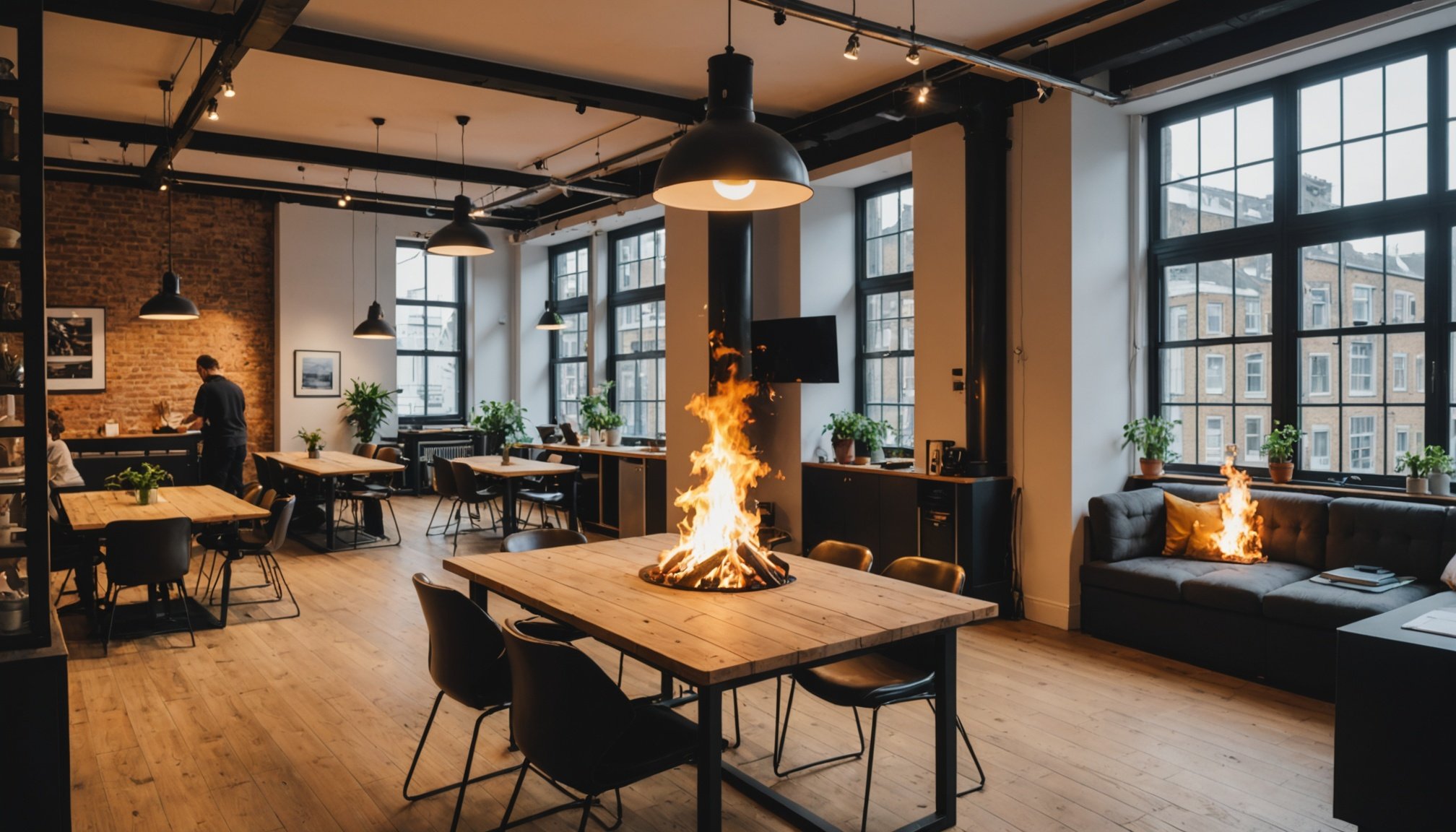Understanding Fire Safety Regulations in the UK Coworking Context
Navigating UK fire safety regulations can be challenging for coworking space operators, but compliance is non-negotiable. The Regulatory Reform (Fire Safety) Order 2005 forms the cornerstone of fire safety laws, mandating that shared workspaces adhere to essential safety protocols. This legislation outlines responsibilities such as risk assessments, which ensure fire hazards are identified and mitigated.
Coworking spaces must be vigilant in meeting compliance requirements. Operators are required to install proper fire detection and alarm systems, maintain unobstructed escape routes, and display clear signage. These measures are critical in ensuring safety and minimizing the risk of fire incidents. Collaborating with fire safety professionals can aid in fulfilling these obligations.
Also read : Launching a UK Virtual Reality Gaming Startup: Essential Compliance with Age-Appropriate Content Standards
Common pitfalls in coworking spaces compliance include overlooking regular maintenance and failing to engage members in safety practices. Ignorance of evolving regulations can lead to non-compliance, potentially resulting in severe penalties. It’s crucial for operators to stay informed about fire safety laws, continually educate staff, and conduct regular safety drills.
Being well-versed in fire safety laws ensures coworking spaces not only meet legal standards but also create secure environments for their users. This proactive approach conveys responsibility and commitment to safety.
In the same genre : Jumpstart Your UK AgTech Startup: Comprehensive Blueprint for Establishing Your Agricultural Tech Firm
Identifying and Managing Fire Hazards in Coworking Spaces
Understanding fire hazards and managing risk are fundamental components in ensuring safety within coworking environments. Establishing safety assessments is a critical step in this process.
Common Fire Hazards in Shared Work Environments
In shared workspaces, fire hazards often include elements such as electrical equipment. Overloaded circuits and improper usage can elevate risks considerably. Kitchens and break areas also present significant dangers, often due to unattended appliances. Additionally, the improper storage of flammable materials needs careful attention to prevent accidents.
Conducting a Fire Risk Assessment
To effectively manage these risks, conducting a thorough fire risk assessment is essential. Start by identifying potential hazards and assessing the potential impact on the space and occupants. Involving coworkers in this process ensures everyone is aware and invested in maintaining safety. Maintaining detailed records not only helps in tracking progress but is critical for regulatory compliance.
Mitigation Strategies for Identified Risks
Post-assessment, implementing effective mitigation strategies is necessary. This includes routine inspections, comprehensive training for staff, and promoting awareness. Utilising fire suppression systems and maintaining equipment adds an extra layer of protection. Regular maintenance and communication keep these measures active and effective, ensuring coworking spaces remain safe and compliant.
Best Practices for Fire Safety Setup in Coworking Spaces
Creating a harmonious blend of functionality and safety is essential in any coworking space setup. One fundamental aspect is ensuring clear evacuation routes. These routes are not just for regulatory compliance but serve as lifelines in emergencies. Mark them with visible and glow-in-the-dark signage to assist during power outages. This promotes a quick and orderly evacuation, significantly reducing risks during a crisis.
A well-thought-out workspace design must include strategic placement of fire extinguishers and alarm systems. Place these tools in accessible and known locations, allowing swift action at the first sign of danger. Regularly inspect these tools to ensure they remain in good working order, thus contributing to a safer working environment.
Incorporating fire safety practices into daily operations is achievable with simple adjustments. Encourage communal responsibility, perhaps through daily checks of potential fire triggers like kitchen appliances. Arrange for routine staff training sessions to build awareness and preparedness.
Finally, consider designing breakout spaces and meeting rooms with fire-resistant materials. These choices not only enhance safety but create a reassuring atmosphere for all users. Prioritising these elements in design underscores commitment to a safer coworking environment.
Emergency Preparedness and Response Plans
Preemptive planning in coworking spaces is paramount for effective emergency preparedness. Without a robust response strategy, even minor incidents can escalate. Importance, therefore, rests on developing a tailored emergency response plan.
The plan must outline clear evacuation procedures. Its core aim is to ensure swift and orderly evacuations, combined with regular drills to instill familiarity. Evacuation drills simulate potential emergency scenarios, equipping coworkers with the necessary actions to take. Understanding one’s role bolsters system efficiency, reducing confusion under stress.
Effective communication strategies boost a response plan’s success. Quick dissemination of accurate information is vital. This involves designating communication leaders and utilising multiple channels, such as intercoms and mobile alerts. With these measures, coworking safety is significantly enhanced during emergencies.
For operators, balancing day-to-day duties with emergency preparedness can seem daunting. However, embedding preparedness into routine procedures demystifies the process. Frequent reassessments ensure that plans remain agile and responsive to any changes within the workspace.
In this light, maintaining preparedness becomes less an operational burden and more a culture of safety. It fosters a proactive environment where users feel reassured, ultimately contributing to an inherently safer coworking community.
Practical Resources and Tools for Fire Safety Compliance
Ensuring fire safety compliance in coworking spaces demands a proactive approach. Access to practical resources simplifies this process, making it manageable for operators.
A comprehensive checklist for fire safety compliance is essential. This checklist should outline routine tasks such as inspecting fire extinguishers and ensuring escape routes remain unobstructed. It serves not only as a reminder but also helps in systematically tackling compliance tasks.
Referencing official UK fire safety guidelines and resources enhances understanding. These resources offer clarity on legal requirements, suggesting steps to ensure compliance. They also provide updates on any regulatory changes, allowing operators to remain informed and prevent lapses in readiness.
For ongoing safety management, practical tools like compliance management software streamline reporting and tracking of safety measures. Such software assists in maintaining records of inspections, drills, and training sessions, ensuring no detail is overlooked.
Creating a culture of safety through accessible resources encourages consistent adherence to fire safety standards. With comprehensive tools and checklists, coworking spaces can achieve a robust compliance strategy, further safeguarding occupants and assets. This proactive stance not only meets legal obligations but also supports the overarching goal of ensuring safety and security.
Case Studies and Real-Life Examples
Understanding how coworking spaces successfully implement fire safety measures offers valuable insights into maintaining safe environments. Let’s explore case studies that illustrate effective safety strategies and lessons learned from real-life incidents.
One notable example is a coworking space in London that excelled in co-working safety by implementing routine evacuation drills and detailed fire risk assessments. By engaging all coworkers in these exercises, they cultivated a strong safety culture. This proactive approach empowered occupants to respond efficiently during a minor kitchen fire, preventing it from escalating.
Another coworking operator in Manchester effectively utilised fire suppression systems. This setup proved critical when an electrical fault caused a small fire. The prompt activation of the extinguishing system minimised damage and downtime, underscoring the importance of advanced safety measures.
Lessons from near-misses also shape safety protocols. A coworking space in Birmingham addressed the absence of clear escape routes by redesigning their layout. Visible signage and marked pathways now guide occupants to safety, reducing evacuation time.
These examples highlight that integrating practical solutions and consistently updating safety protocols are pivotal in ensuring fire safety compliance. They demonstrate how adapting to lessons learned can bolster overall preparedness, protecting both individuals and assets in coworking spaces.











